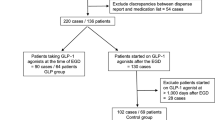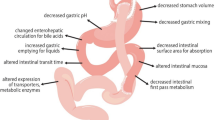Abstract
Objectives
Chronic intestinal pseudo-obstruction (CIPO) is a challenging disorder with high morbidity and mortality due to limited effective therapies that improve enteral tolerance. We aimed to present our experience using octreotide in children with CIPO and evaluate factors predicting therapy response.
Methods
The study population included total parenteral nutrition (TPN)-dependent children with CIPO receiving octreotide at a tertiary care center. Octreotide response was defined as an enteral feeding increase of ≥10 cc/kg/day.
Results
A total of 16 children were included (median age 5 years, range 1–18; 88 % female). We observed an overall feed increase in 11/16 (69 %) subjects and 7/16 (44 %) were considered responders: three tolerated >65 cc/kg/day (discontinued TPN), one tolerated >30 cc/kg/day (decreased TPN) and three patients tolerated 10–12 cc/kg/day. We found an association between therapeutic octreotide response and both the presence of octreotide-induced intestinal phase III of the migrating motor complex (MMC) as well as a higher median increase in intestinal motility index after octreotide challenge during the antroduodenal manometry (p = 0.03 and <0.01, respectively). We did not find an association between octreotide response and age, presence of ileostomy, and colonic manometry testing parameters. Side effects were observed in four patients: an allergic reaction and hyperglycemia requiring octreotide discontinuation, hypertension that responded to dose reduction, and cholecystitis (gallstones) with octreotide successfully restarted after cholecystectomy.
Conclusions
Octreotide is safe and effective in improving enteral tolerance in TPN-dependent children with CIPO and the antroduodenal manometry may be helpful in predicting octreotide response. Prospective studies are needed to evaluate the safety and efficacy of octreotide in children with CIPO.


Similar content being viewed by others
References
Di Lorenzo C, Lucanto C, Flores AF, Idries S, Hyman PE. Effect of octreotide on gastrointestinal motility in children with functional gastrointestinal symptoms. J Pediatr Gastroenterol Nutr. 1998;27(5):508–12 (Epub 1998/11/20).
Lecomte T, Cavicchi M, Delchier JC. Small bowel pseudo-obstruction revealing an early scleroderma. Long-term efficacy of octreotide and erythromycin. Gastroenterol Clin Biol. 2000;24(3):361–3 (pii: MDOI-GCB-03-2000-24-3-0399-8320-101019-ART16. Epub 2000/05/11).
Leonardi G, de Bortoli N, Bellini M, Mumolo MG, Costa F, Ricchiuti A, et al. Intestinal pseudo-obstruction in inactive systemic lupus erythematosus: An unusual finding. World J Gastrointest Pharmacol Ther. 2010;1(6):135–6. doi:10.4292/wjgpt.v1.i6.135 (Epub 2011/05/18).
Ishikawa M, Okada J, Kondo H. Five cases of systemic sclerosis with associated with intestinal pseudo-obstruction. Ryumachi. 1999;39(5):768–73 (Epub 1999/12/30).
Lanting PJ, Kruijsen MW, Rasher JJ, van den Hoogen FH, Boerbooms AM, van de Putte LB. Severe intestinal pseudoobstruction in a patient with systemic sclerosis. Successful treatment with octreotide. J Rheumatol. 1993;20(12):2175 (Epub 1993/12/01).
Kobayashi T, Kobayashi M, Naka M, Nakajima K, Momose A, Toi M. Response to octreotide of intestinal pseudoobstruction and pneumatosis cystoides intestinalis associated with progressive systemic sclerosis. Intern Med. 1993;32(7):607–9 (Epub 1993/07/01).
Suzuki C, Ohara M, Yamamoto M, Naishiro Y, Yamamoto H, Takahashi H, et al. A case of scleroderma-polymyositis overlap syndrome in which octreotide exacerbated abdominal symptoms. Nihon Rinsho Meneki Gakkai Kaishi. 2005;28(1):56–61 (pii:JST.JSTAGE/jsci/28. Epub 2005/03/04).
Soudah HC, Hasler WL, Owyang C. Effect of octreotide on intestinal motility and bacterial overgrowth in scleroderma. N Engl J Med. 1991;325(21):1461–7. doi:10.1056/NEJM199111213252102 (Epub 1991/11/21).
Verne GN, Eaker EY, Hardy E, Sninsky CA. Effect of octreotide and erythromycin on idiopathic and scleroderma-associated intestinal pseudoobstruction. Dig Dis Sci. 1995;40(9):1892–901 (Epub 1995/09/01).
Perlemuter G, Cacoub P, Chaussade S, Wechsler B, Couturier D, Piette JC. Octreotide treatment of chronic intestinal pseudoobstruction secondary to connective tissue diseases. Arthritis Rheum. 1999;42(7):1545–9. doi:10.1002/1529-0131(199907)42:7<1545::AID-ANR30>3.0.CO;2-T (Epub 1999/07/14).
Nikou GC, Toumpanakis C, Katsiari C, Charalambopoulos D, Sfikakis PP. Treatment of small intestinal disease in systemic sclerosis with octreotide: a prospective study in seven patients. J Clin Rheumatol. 2007;13(3):119–23. doi:10.1097/RHU.0b013e3180645d2a (Epub 2007/06/07).
Sharma S, Ghoshal UC, Bhat G, Choudhuri G. Gastric adenocarcinoma presenting with intestinal pseudoobstruction, successfully treated with octreotide. Indian J Med Sci. 2006;60(11):467–70 (Epub 2006/11/09).
Sorhaug S, Steinshamn SL, Waldum HL. Octreotide treatment for paraneoplastic intestinal pseudo-obstruction complicating SCLC. Lung Cancer. 2005;48(1):137–40. doi:10.1016/j.lungcan.2004.09.008 (Epub 2005/03/22).
Dalgic B, Sari S, Dogan I, Unal S. Chronic intestinal pseudoobstruction: report of four pediatric patients. Turk J Gastroenterol. 2005;16(2):93–7 (Epub 2005/10/28).
Rudolph CD, Hyman PE, Altschuler SM, Christensen J, Colletti RB, Cucchiara S, et al. Diagnosis and treatment of chronic intestinal pseudo-obstruction in children: report of consensus workshop. J Pediatr Gastroenterol Nutr. 1997;24(1):102–12 (Epub 1997/01/01).
Di Lorenzo C, Flores AF, Reddy SN, Hyman PE. Use of colonic manometry to differentiate causes of intractable constipation in children. J Pediatr. 1992;120(5):690–5.
Berseth CL. Minimal enteral feedings. Clin Perinatol. 1995;22(1):195–205 (Epub 1995/03/01).
Owens L, Burrin DG, Berseth CL. Minimal enteral feeding induces maturation of intestinal motor function but not mucosal growth in neonatal dogs. J Nutr. 2002;132(9):2717–22 (Epub 2002/09/11).
Shou J, Lappin J, Minnard EA, Daly JM. Total parenteral nutrition, bacterial translocation, and host immune function. Am J Surg. 1994;167(1):145–50. doi:10.1016/0002-9610(94)90065-5 (Epub 1994/01/01).
Okada Y, Klein N, van Saene HK, Pierro A. Small volumes of enteral feedings normalise immune function in infants receiving parenteral nutrition. J Pediatr Surg. 1998;33(1):16–9 (pii:S0022-3468(98)90352-9. Epub 1998/02/24).
Descamps V, Duval X, Crickx B, Bouscarat F, Coffin B, Belaich S. Global improvement of systemic scleroderma under long-term administration of octreotide. Eur J Dermatol. 1999;9(6):446–8 (Epub 1999/09/24).
Sjolund K, Bartosik I, Lindberg G, Scheja A, Wildt M, Akesson A. Small intestinal manometry in patients with systemic sclerosis. Eur J Gastroenterol Hepatol. 2005;17(11):1205–12.
Folwaczny C, Laritz M, Meurer M, Endres SP, Konig A, Schindlbeck N. Effects of various prokinetic drugs on gastrointestinal transit times in patients with progressive systemic scleroderma. Z Gastroenterol. 1997;35(10):905–12 (Epub 1998/02/12).
Pavlovic M, Saiag P, Lotz JP, Marinho E, Clerici T, Izrael V. Regression of sclerodermatous skin lesions in a patient with carcinoid syndrome treated by octreotide. Arch Dermatol. 1995;131(10):1207–9 (Epub 1995/10/01).
Yarze JC, Chase MP. Free intra-abdominal gas associated with octreotide use: intestinal perforation or benign pneumoperitoneum associated with underlying systemic sclerosis? Am J Gastroenterol. 2002;97(7):1844–5. doi:10.1111/j.1572-0241.2002.05865.x (Epub 2002/07/24).
Malcolm A, Ellard K. Intestinal perforation associated with octreotide therapy in scleroderma. Am J Gastroenterol. 2001;96(11):3206–8. doi:10.1111/j.1572-0241.2001.05286.x (Epub 2001/11/28).
Author information
Authors and Affiliations
Corresponding author
Ethics declarations
Funding
This work was supported in part by NIH K24DK082792A (SN).
Conflict of interest
LA: no disclosures, AF: no disclosures, SN: no disclosures, LR: no disclosures.
Rights and permissions
About this article
Cite this article
Ambartsumyan, L., Flores, A., Nurko, S. et al. Utility of Octreotide in Advancing Enteral Feeds in Children with Chronic Intestinal Pseudo-Obstruction. Pediatr Drugs 18, 387–392 (2016). https://doi.org/10.1007/s40272-016-0189-x
Published:
Issue Date:
DOI: https://doi.org/10.1007/s40272-016-0189-x




